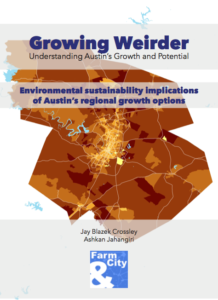In the Austin region, we must reduce our metropolitan carbon emissions to play a responsible role in the 21st century world community. Unfortunately, many of our public policies continue to increase our carbon footprint – especially land use and transportation policies.
As we grow from two to four million, we have the opportunity to lower our carbon footprint significantly by allowing existing and new residents better options to live healthy, low-carbon lifestyles, by reducing car dependency.
Cutting the region’s vehicle miles traveled is a crucial element of climate responsibility, which will primarily be determined by our regional growth policies, especially CodeNEXT and the 2045 Regional Transportation Plan.
In addition, current zoning is responsible for many of Austin’s localized flooding problems. Passing a CodeNEXT that aggressively allows more people to live in the City of Austin would reduce future regional impervious surface.
Getting rid of exclusionary, environmentally destructive land development code is not a new experiment for the Austin region. The UNO provisions, which have allowed for extraordinary growth and dramatic improvements to the West Campus area should be replicated across the urban grid.
Download the full report
GrowingWeirder_Sustainability (pdf)
Printable version: GrowingWeirder_Sustainability_Printable (pdf)
Growing Weirder is our initiative to advocate for equitable, sustainable regional growth through the two major planning decisions currently underway in the Austin region. The City of Austin’s land use and development code rewrite, CodeNEXT, will determine what proportion of the 700,000 newcomers over the next ten years will be allowed to live in the City of Austin. CAMPO’s 2045 Regional Transportation Plan (RTP) will determine many aspects of the region’s future, including the possible conversion of up to 650 square miles of rural areas to sub-urban or urban.
Farm&City produced a number of reports taking an in-depth look at the different factors influenced by these broad decisions, with some surprising conclusions. This work provides direction for the planning efforts listed above: if it is more affordable to live in a more compact, connected city, equitable long-term decisions should work to provide meaningful options for living in such places.
Growing Weirder is made possible through the generous support of our sponsors: GreaterAustin Neighborhoods, Blazek & Vetterling, Impact Hub Austin, and My Brilliant City.

